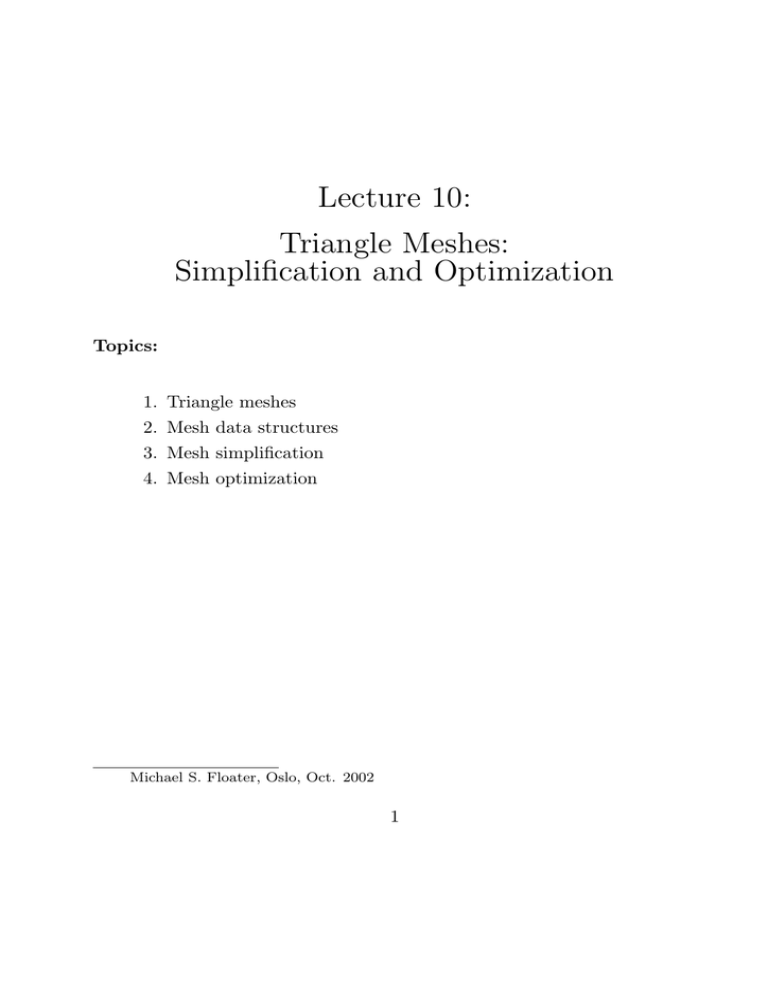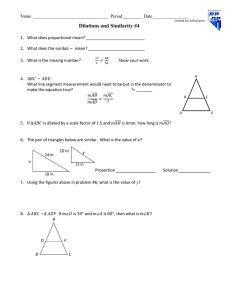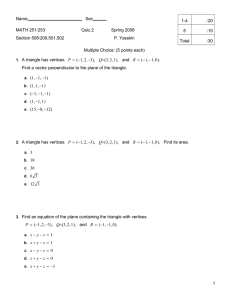Lecture 10: Triangle Meshes: Simplification and Optimization
advertisement

Lecture 10:
Triangle Meshes:
Simplification and Optimization
Topics:
1.
2.
3.
4.
Triangle meshes
Mesh data structures
Mesh simplification
Mesh optimization
Michael S. Floater, Oslo, Oct. 2002
1
Polygonal meshes
A polygonal mesh is a set of faces (polygons) in lR3 such that
(i) the intersection between any pair of faces is either a common edge, a
common vertex, or nothing:
and
(ii) the union of the faces is a manifold surface (with or without boundary).
Condition (ii) implies that the mesh looks locally like a surface. It
requires that (a) each edge belongs to either one or two faces:
and (b) the faces incident on a vertex form an open or closed ‘fan’:
2
Edges belonging to only one face form the boundary (if any) of the mesh.
The boundary (if any) consists of one or more loops.
The orientation of a face is the cylic order of its incident vertices. There
are two possible orientations of each face: clockwise and anti-clockwise. The
orientation of two adjacent faces is compatible if the two vertices of their
common edge are in opposite order. A mesh is said to be orientable if
there exists a choice of face orientations that makes all pairs of adjacent
faces compatible.
The Euler formula describes the relationship between the number
of vertices v, edges e, faces f , and the topological type of an orientable
manifold mesh. The topological type is given by the Euler characteristic
χ, and the Euler formula is
χ := v − e + f.
A mesh is said to have genus g if it can be cut along 2g closed loops
without disconnecting it. The sphere and torus have genus zero and one
respectively. The double torus has genus two etc. Any mesh of genus g
can be continuously deformed into a sphere with g handles.
3
If s is the number of connected components, g the genus and b the
number of boundary loops, it can be shown that
χ = 2(s − g) − b.
In the special case of a closed manifold triangular mesh each edge has
exactly two incident triangles and each triangle has three incident edges,
thus
2e = 3f.
This yields
2v − f = 2χ,
and as χ is typically small,
f ≈ 2v.
A mesh is sometimes called simple if it is connected, orientable, of
genus zero, and has one boundary loop.
Geometry and connectivity. We can view the mesh as consisting of
geometry, i.e., the vertices, and connectivity, i.e. the graph which specifies which pairs of vertices are neighbours. Two vertices are neighbours
if they are the end points of an edge. The graph can be written as G(V, E).
Each vertex in the mesh can be represented by an integer index i in V and
each edge can be represented as a pair (i, j) in E.
4
Mesh data structures
It is usual to represent the mesh geometry as a vector-valued array of floats
or doubles:
x0 y0 z0
x1 y1 z1
...
xm ym zm
The connectivity is often defined by a face vertex incidence table. For
each face an oriented cyclic list of indices of the incident vertices is given.
In VRML the IndexedFaceSet defines the face-vertex incidence table by
one list of indices, where the −1 separates different faces:
i0 j0
i1 j1
i2 j2
....
in jn
k0 l0 -1
k1 -1
k2 l2 m2 -1
kn -1
The order of the vertex indices in a face defines the orientation. For a
triangle mesh, no −1 is needed as every face has three vertices:
i0 j0 k0
i1 j1 k1
...
in jn kn
5
This simple data structure could be organized in three C++ classes: Triangle, Node, and TriangleMesh. The class TriangleMesh would consist
of two arrays, one of Triangle’s and the other of Node’s. The following
diagram indicates that Triangle has (three) pointers to Node.
Triangle
Node
This data structure is fine for simple visualization of the triangles.
However, it is not good when we need neighbourhood information. We
might for example wish to estimate normals at the vertices for use in
Gouraud shading. This requires finding all triangles which contain a give
vertex. The only way to find these triangles is to check all triangles in the
triangle array. Thus if there are N triangles, finding one neighbourhood
costs O(N ) time. Repeating this for each node, and since the number of
nodes is about N/2, we end up with an O(N 2 ) algorithm for estimating all
the normals. For N in the region of 106 this is not an option.
The solution is to enrich the data structure by adding further pointers.
One possibility is to add three pointers to the neighbouring triangles in the
Triangle class.
vk
t1
t2
vj
vi
t3
6
There are then six data members in the Triangle class:
i j k
t1 t2 t3
with the convention that the first/second/third triangle pointer refers to
the triangle opposite the first/second/third vertex. The dependencies are:
Triangle
Node
If we traverse the vertices by traversing the triangles, and for each
triangle checking which of the three vertices have been visited, we can use
the three triangle pointers to find all incident triangles to each vertex. Thus,
for example, all normals in the mesh can now be estimated in O(N ) time.
Note that when building this enhanced data structure from the original, all
the triangle pointers can be found in O(N ) time.
A further help to traversing vertices is to add pointers to the Node
class. One can simply add a list of pointers to all incident triangles. Another option which uses less space is to add just one pointer to one of the
containing triangles.
v
v
t
t
7
The enhanced Node class now take the form
x y z
t
and the data structure now has the dependencies:
Triangle
Node
It is now easy to write a getNeighbours(int i) routine which returns
(in O(1) time) an ordered list of the neighbouring nodes of the given i-th
node.
There are many possible data structures for triangle meshes, and all
have advantages and disadvantages. Many data structures include an additional Edge class and one or more of the dependencies:
Triangle
Edge
Some data structures use ‘half-edges’ instead of edges.
8
Node
Mesh simplification
Frequently we encounter triangle meshes with very large numbers of triangles and vertices; these data sets often come from scanning millions of
points from real objects. It is therefore important to be able to reduce or
simplify the mesh if necessary.
A common way to simplify a mesh is to apply an incremental algorithm, removing one vertex at a time and repairing the hole left by the
removal. Ideally, we want to remove as many vertices as we can so that the
remaining coarse mesh is still a good enough approximation to the original
fine mesh.
9
There are three common ways to remove a vertex and repair the hole:
vertex removal, edge collapse and half-edge collapse.
Vertex removal
Edge collapse
Half edge collapse
Vertex removal simply means retriangulating the hole left by removing a vertex p. If there were k triangles sharing p, there will be k − 2 in
the repaired mesh. Note that the number of edges incident on p was also k
and is now k − 3. Since the number of vertices is reduced by 1, we see that
the Euler characteristic χ = v − e + f is unchanged, reflecting the fact that
vertex removal is an Euler operation; it does not change the topology of
the mesh. We will not study Non-Euler operations.
10
An edge collapse takes two neighbouring vertices p and q an collapses
the edge betwen them to a new point r. As a result, two triangles become degenerate and are removed from the mesh. This is again an Euler
operation.
A third, and popular, Euler operation is a half-edge collapse in which
for some ordered pair of neighbouring vertices (p, q), we ‘move’ p to q. Again
two triangles become degenerate and are removed. It can be thought of as
a special case of edge collapse where the new position r is taken to be q. It
is also the special case of vertex removal in which the triangulation of the
k-sided hole is generated by connecting all neighbouring vertices with q.
Removal criteria. In each removal step, the best candidate for removal is
determined by some user-specified criterion. For example, we might remove
that vertex which results in the smallest distance between the previous mesh
and the new one. We might instead remove vertices where the density of
vertices is highest, in order to get an even distribution of vertices. A third
alternative is to try to maintain good aspect ratios in the triangles (avoiding
long thin triangles). One could try to combine several of these criteria.
Implementation. For our chosen removal criterion we compute, for each
vertex p, some measure sig(p) of the how significant the vertex p is. Once
we have sig(p) for every vertex p in the mesh, we can remove any vertex p ∗
such that
sig(p∗ ) = min sig(p).
p∈V
Most (efficient) criteria are local, so that sig(p) depends only on p and its
(immediate) neighbours.
11
Use of heap. A naive implementation of the decimation algorithm computes sig(p) for each p in the current mesh after every removal. If there are
N vertices in the orginal mesh, this costs O(N 2 ) operations. An enormous
improvement is to employ a heap data structure, exploiting the fact that
sig(p) remains constant for the vast majority of the vertices p in the current
mesh. As a preprocess, we compute sig(p) for all vertices p in the fine mesh
and place the vertices p in a heap together with the sig(p) values. A heap is
organized as a binary tree, with the vertex p with the smallest sig(p) value
at the root of the heap.
We then start decimating. At each step, the vertex to remove is at the
root of the heap and so we remove it both from the mesh (and repair the
hole) and from the heap. We then only need to update the heap with the
new significance values of the vertices that were neighbours of p.
Popping the root of the heap costs only log(N ) operations (since the
heap has depth log(N )), and similarly updating one sig value costs log(N ).
Thus one whole vertex removal costs only log(N ) operations (assuming the
number of neighbours is bounded). Thus the total decimation algorithm
costs only O(N log(N )) operations.
Note that when using half-edge collapses, we could assign a significance
to each ordered vertex pair (p, q), and the heap would contains these pairs
rather than the vertices themselves.
12
A final word of caution. Care has to be taken when removing vertices.
Consider removing v0 in the figure below, leaving a four-sided hole, shaded.
v
4
v
0 v1 v
3
v 2
It would be fine to triangulate the hole by connecting v 1 and v3 . We
could not however use the alternative of connecting v2 and v4 , the reason
being that v2 and v4 are already neighbours in the mesh. Thus connecting
v2 and v4 would yield a non-simple graph (a graph is simple if no pair of
vertices belong to more than one edge). Most data structures for triangle
meshes are designed on the assumption that the graph is simple.
Such problems are easily avoided by simply not allowing such connections. The rule to remember in vertex removals is never connect two
vertices that are already connected.
Such possiblities tend to occur more and more frequently as the mesh
is simplified. Of course, if we simplify until there are only a handful of
vertices left, it may not be possible to make any further vertex removals,
e.g. if the mesh is a tetrahedron, with just four vertices.
13
Mesh optimization
Mesh optimization is conceptually simpler than mesh simplification. The
idea is simple. Without changing the vertices, can we change the connectivity of the mesh in order to achieve a better quality surface? The usual
approach is edge swapping. Each pair of triangles sharing a common
edge form a quadrilateral. The simplest change in connectivity we can
make is to swap the given diagonal of a quadrilateral with the other one. In
the figure below we swap the edge [v1 , v3 ] with [v2 , v4 ]. This has the effect
of replacing the two triangles [v1 , v2 , v3 ] and [v1 , v3 , v4 ] by [v1 , v2 , v4 ] and
[v2 , v3 , v4 ].
v4
v4
v3
v3
Edge swap
v1
v1
v2
v2
As with vertex removal, care must be taken not to invalidate the mesh
by creating a non-simple graph. Thus if v2 and v4 on the left are already
connected by an edge outside the quadrilateral, we cannot perform the
swap.
14
By applying several edge swaps we gradually change the original mesh into
a better one. We choose some cost function we wish to minimize and
the swap criterion is then simply whether the swap decreases the cost
function. We keep on swapping edges which result in a decreased cost
function, until no further decreases are possible. Usually it is not possible
to guarantee that the global minimum can be reached by a sequence of
swaps, but the result is often a better mesh anyway.
For planar triangle meshes, there is a very well known swap criterion,
called the Delaunay criterion. We swap the edge [v1 , v3 ] (of a convex
quadrilateral) if the vertex v3 lies outside the circumcircle of the triangle
[v1 , v2 , v4 ], as is in the following figure.
v4
v4
v3
v
Delaunay swap
v1
v
v
3
1
v2
2
This swapping procedure was proposed by Lawson and it is equivalent
to the max-min angle criterion; we swap if the minimum of the six angles
in the two triangles is increased.
The beauty of the Delaunay swap criterion is that it always leads to a
unique triangulation of the planar points (at least if there are no cocircular
points). When no more swaps can be made, the triangle mesh is a Delauanay triangulation of the plane, i.e., a triangulation in which the interior
15
of the circumcircle of each triangle is empty (contains no other vertices of
the triangulation). A Delaunay triangulation has the property that the
minimum of all the angles of its triangles is maximized. Thus the Delauany
swap criterion tends to give ‘well-shaped’ triangles where possible.
Delaunay triangulation have several nice properties. A Delauanay triangulation of a set of planar points is the dual graph of their Voronoi
diagram. The Voronoi diagram of a set of planar points p 1 , . . . , pN is a
collection of tiles. There is one tile Vi associated with each point pi . The
i-th tile Vi is simply the set of all points in lR2 that are closer to pi than
any other point pj , i.e.,
Vi = {x ∈ lR2 : kx − pi k ≤ kx − pj k ∀j 6= i}.
The figure below shows the Delauanay triangulation (solid) of a set of planar
points and their Voronoi diagram (dashed).
16
For triangle meshes in lR3 the circumcircle criterion no longer makes sense,
and though the max-min angle criterion could be used, a unique solution is
no longer guaranteed.
In fact in the lR3 case we often use optimization criteria which reflect
the geometry of the surface. For example we might optimize the ‘smoothness’ of the mesh, by minimizing the angle between the normal directions
of adjacent triangles, or by minimizing some discrete measure of curvature.
The figure below show various optimizations of a given toroidal-shaped triangle mesh.
17




